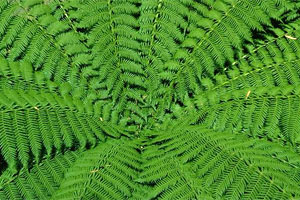 Ferns for Cool Climates
Ferns for Cool Climates
There are a number of Australian native fern species which are relatively easy
to grow outdoors in cool climate areas.Ferns require good drainage and it is important that some form of protection, such as overhanging trees, shrubs, a garden wall, the wall of a house or shade cloth, is provided. Where there are extremes of dry heat and cold, suitable growing conditions can be developed by enclosing areas sufficiently to keep the humidity high.
When planning the site for a fern garden, easterly and southerly aspects are preferable. The majority of ferns grow best in filtered sunlight and although some will tolerate direct sunlight, they should not be subjected to it for long periods.
Frost damage may occur to fronds, but it will not be as severe if regular watering is kept up throughout winter. Damage to foliage may also occur during long periods of dry heat and wind. Damaged fronds will not recover and should be removed.
Preparation of Soil
Ferns generally grow best in slightly acid soils which contain plenty of organic matter. Good soil conditions can be created by digging to spade depth and incorporating liberal quantities of coarse peat moss, well-rotted leaf-mould or compost. The structure of heavy soil may be improved by the addition of gypsum and coarse sand.Planting
Spring is the best time for planting, although a number of species do equally well if planted in early autumn. Mulching is important to keep weeds down and the soil moist. Eucalyptus leaf litter, hardwood shavings, weathered she oak (Casuarina and Allocasuarina ) needles or oak leaf litter make good mulches. Mulches should be topped up regularly.Fertilising
Ferns are gross feeders and fertilisers are best applied during the warm months when plants are growing. Blood and bone or liquid organic fertilisers such as fish emulsion are suitable. Iron deficiency is common in ferns and can be corrected by applying iron chelates to the soil at the recommended rate. Typical symptoms are yellowing and bleaching of young fronds although, these symptoms may also occur in areas where there is high light intensity.Maintenance
Apart from the removal of dead fronds, ferns do not require a great deal of maintenance and, once established, the soil surface should be disturbed as little as possible. Daily watering is necessary while plants are young, even during winter. This should consist of deep soaking about once a week followed by a light daily watering. During the summer, watering needs to be consistent. Automatic sprinkler and drip irrigation systems are ideal for this purpose.Propagation
Some ferns are readily propagated by means such as division of the rhizomes (under ground stems) or crowns, layering and plantlets. Division is best carried out just prior to the active growth period in spring. The rhizomes can be cut into lengths and those with a growing tip can be potted up. Fronds attached to the divisions may die but new fronds will grow.Some ferns, such as Asplenium bulbiferum and Polystichum species, produce small plantlets or bulbils along the stem or on, or near, the tip of the fronds. Plantlets can be pegged onto the ground and removed from the parent plant once roots are developed.
Ferns may also be propagated from spores.
Pests
Some common pests of ferns and the method of control are listed. Many ferns, especially fine-foliaged species, are sensitive to pesticides and care should be exercised in their application. When using pesticides, safety directions should be followed carefully.Caterpillars (late summer) can be are controlled by crushing the animals by hand, or, in cases of severe infestation, a spray such as Carbaryl" may be applied.
Slugs and snails require regular baiting with snail bait, especially after wet weather.
Aphids may attack new fronds especially in spring and autumn and can be controlled with a contact spray such as those based on Pyrethrum extract.
Scale insects are generally found on stems and on the undersurfaces of fronds. They may be brushed from the surface using a toothbrush or, in cases of severe infestation, white oil and 'Rogor 40' or 'Folimat' may be used. Foliage 'burn' may occur if these pesticides are used when temperatures exceed 25 degrees C.
Australian Native Fern Species for Cool Climate Areas
Many of these are sensitive to frosts and need protection.
Adiantum aethiopicum (Maidenhair)
Asplenium australasicum (Bird's Nest Fern)
A. bulbiferum (Mother Spleenwort)
A. flabellifolium (Necklace Fern)
Blechnum nudum (Fishbone Water-fern)
B. patersonii (Strap Water-fern)
B. wattsii (Hard Water-fern)
Cheilanthes austrotenuifolia (Rock Fern)
C. sieberi (Rock Fern)
Cyathea australis (Rough Tree-fern)
Culcita dubia (False Bracken)
Dicksonia antarctica (Soft Tree-fern)
Doodia aspera (Prickly Rasp Fern)
Gleichenia dicarpa (Pouched Coral-fern)
Histiopteris incisa (Bat's-wing Fern)
Hypolepis glandulifera
H. muelleri
H. rugosula (Ruddy Ground-fern)
Microsorium diversifolium (Kangaroo Fern)
Pellaea falcata var. falcata (Sickle-fern)
Pellaea falcata var. nana (Dwarf Sickle-fern)
Platycerium superbum (Staghorn)
Polystichum proliferum (Mother Shield-fern)
P. australiense
Sticherus flabellatus (Umbrella Fern)
Todea barbara (King Fern)
Suggested Reading
- Duncan, B.D. and Issac, G. (1986) Ferns and allied plants of Victoria, Tasmania and South Australia, Melbourne University Press
- Goudey, C.J. (1988) A Handbook of Ferns for Australia and New Zealand, Lothian
- Jones, D.L. and Clemesha, S.C. (1981) Australian Ferns and Fern Allies, 2nd edition, Reed
- Jones, D.L. (1987) Encyclopaedia of Ferns, Lothian
Visit the fern web site
![An Australian Government Initiative [logo]](/images/austgovt_brown_90px.gif)







